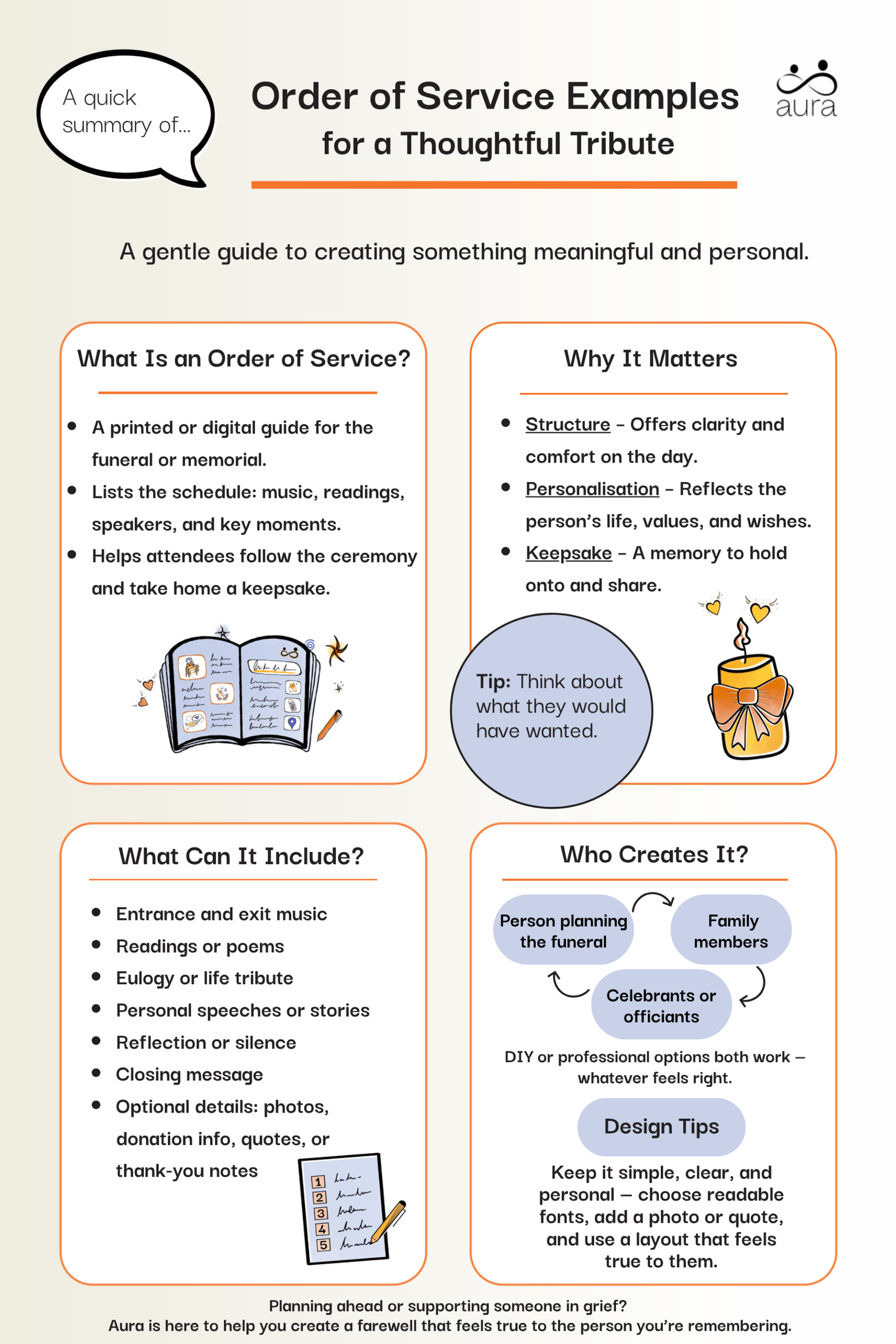


Written by Emily Cross.
13 minute read
Article reviewed by Judy Carole, Published Author on May 8, 2025.
If you’re reading this, you might be in the midst of grief…or supporting someone who is. Whether you’ve lost someone recently, are being a good friend, or you’re planning ahead, it can feel overwhelming trying to figure out where to begin. At Aura, we understand how difficult these moments can be. Planning a funeral isn’t just about logistics — it’s about honouring a life and creating space for connection, comfort, and remembrance.
That’s where the funeral order of service becomes so important. It’s more than just a schedule… it’s a reflection of the person you’re remembering, their values, their story, and the memories they leave behind. In this guide, we’ll share order of service examples to help you create something both meaningful and practical, from traditional funerals to more personal celebration of life events, including simple cremations.
Key takeaways:

The order of service is a printed or digital programme that guides attendees through the funeral. It typically outlines each stage of the ceremony, including readings, music, and who is speaking when. Though it’s an optional element, many families find it brings clarity and comfort, offering a gentle guide through the emotions of the day, and helping people understand what happens at a funeral, especially if they’ve never attended one before. It also serves as a keepsake to take home and cherish.
For those wondering, ‘how much does a funeral cost?‘, it’s worth knowing that while an order of service can add to the expense, it doesn’t have to be elaborate to be meaningful—and some choose to create their own to keep costs low.
Whether it’s for a traditional church funeral, a memorial service, or a direct cremation followed by a private gathering, the order of service helps people come together to share in memory and mourning and to celebrate a life.
In most cases, the person arranging the funeral or memorial takes the lead on putting the order of service together. This is often a close family member, friend, or executor. But you don’t have to figure it all out on your own. This part of planning can be emotional, and there’s nothing wrong with asking for help.
If you’re working with an officiant or celebrant, they’ll often assist with the layout, wording, and printing, or connect you with someone who can. You might also find it helpful to involve other family members… for example, one person choosing the music, another writing a short biography, and someone else proofreading or designing the layout.
A traditional order of service is usually more formal and may follow religious or cultural customs. Here’s a typical layout:
Religious funerals often follow a well-established structure shaped by centuries of custom. These ceremonies can offer a sense of familiarity and spiritual grounding, which can be comforting and grounding for families.
For example, Christian services usually include hymns, scripture readings, and prayers — often drawn from a church’s funeral liturgy. Catholic funerals may also include a Mass. In Jewish tradition, funerals are typically held quickly after death, with readings from the Psalms and the Mourner’s Kaddish. Islamic funerals are often simple, solemn occasions, with specific rites such as ritual washing of the body, collective prayers (Janazah), and a swift burial.
Each faith has its own language of mourning and remembrance, and the order of service plays a key role in guiding attendees through that journey. Because these traditions are very meaningful and sometimes nuanced, it’s wise to work closely with a faith leader or an experienced funeral director. They can help you honour beliefs respectfully, and ensure everything is carried out with care and cultural sensitivity.
Secular or humanist ceremonies offer a great deal of flexibility, allowing families to design a tribute without the use of religious content. These often focus on memories, music and storytelling.
Here’s an example:
These ceremonies often feel more like a celebration of life, blending grief with gratitude and shared memories.
A cremation service may take place at a crematorium, a place of worship, or even a family home. It can be religious, completely secular or somewhere in the middle, and many families use this time to reflect quietly, share music, and say goodbye in their own way.
Whether it’s a small, intimate funeral at the crematorium or a later memorial, having something to guide people through the music, readings, and moments of reflection can bring comfort and structure. It reassures everyone that this is still a space to grieve, to remember, and to celebrate, no matter the setting.
Structure might include:
Memorial services offer a greater amount of freedom from traditional structure. They generally happen after cremation or burial, and can be held anywhere: from a garden to a hall, to a beach or a pub. For these more relaxed or informal memorials, you might not need a full order of service at all. But a simple guide or welcome note can still be helpful.
It might list who’s speaking (if anyone), where guests can find refreshments, a quiet space for reflection, or areas where memories or messages can be shared. Even a small card or sign with a few gentle prompts can offer just enough structure while keeping the atmosphere casual, personal and easy-going.
However, if you do wish to include this element, the structure could look something like this:
These end-of-life celebrations can be filled with warmth, humour, and meaningful personal touches.
Clarity and warmth are key when writing an order of service. Keep it simple, sincere, and consider the emotional state of attendees. The wording you choose will often reflect the tone of the funeral — a formal religious service may call for more traditional language, while a relaxed celebration of life might suit something conversational or even gently humorous. Here’s some suggestions on how you can approach wording each section:
Using this kind of language helps attendees feel more at ease, especially those unfamiliar with what happens at a funeral.
While the order of service mainly outlines the flow of the funeral or memorial, it can also be a place for heartfelt extras. Adding personal touches like a short life story, a favourite quote, or a meaningful lyric can help those attending feel more connected to the person they’re remembering.
Other optional additions include a message of thanks from the family, donation details for a chosen charity, or even instructions for what’s happening after the service like a wake or informal gathering. Some families include photo collages or tributes written by grandchildren. These details may be small, but they can leave a lasting impression and offer comfort long after the day is over.

Once you’ve decided what to include in the order of service, the next step is putting it together in a format that feels respectful, clear, and accessible. Whether it’s printed professionally or created at home, the design doesn’t need to be complicated, just thoughtful. Many families choose a favourite photograph for the cover, along with the person’s full name, date of birth and death, and perhaps a short phrase like In Loving Memory or A Celebration of Life.
Inside, the structure should be easy to follow. Use simple fonts and avoid overcrowding the pages. A 2–4 page folded leaflet is often enough for most services, depending on how many readings or songs are included. You might also want to include a brief biography or some words of thanks from the family. For printing, you can either ask your officiant or celebrant for help, if using one, use a local printer, or create a digital version to share online.
When it comes to the physical details, there are a few extra design choices that can make a big difference, both practically and emotionally.
Think about the texture and finish of the paper. Do you want something smooth and glossy, or would a more natural, textured paper feel more fitting? Some families choose recycled paper or minimalist digital formats for eco-conscious reasons–a great option if sustainability mattered to the person being remembered.
Before printing the full batch, you can ask for a proof copy to check layout, clarity and colours. This can help avoid last-minute surprises and gives you a chance to test for accessibility, too. If any guests are partially sighted or elderly, you may choose to opt for larger print sizes, clear fonts, and good contrast between text and background.
Little details like these can help everyone feel included and supported and they show care in the quietest of ways.
Aura offers top-rated direct cremation services — simple, no-fuss funerals for people who prefer to keep things straightforward. Without the complexities of traditional funerals, families have the space to say goodbye in their own way.
With both attended and unattended options available, direct cremation offers flexibility to suit different needs. Some families choose a quiet, unattended direct cremation, no formal service, just dignified care and return of the ashes. Others may prefer to be present for a simple goodbye at the crematorium.
Either choice gives you space to plan a personal celebration of life later on — one that feels right, without the strain of time or tradition. It’s a thoughtful, low-cost alternative that still honours the person with care, compassion, and respect. Aura also offers prepaid funeral plans, and support with every step of funeral planning, including our funeral arrangements checklist to help families stay organised.
Whether you’re planning a traditional funeral, organising a memorial, or choosing a more modern direct cremation, what matters is honouring the person in a way that feels right.
And if you’re unsure where to begin, you’re not alone. Aura is here to guide you gently, helping turn a time of loss into a chance to reflect, remember and celebrate. If you’re in need of support, our team of experienced arrangers, known as Aura Angels, are just a call away.



Do I need to make an order of service?
Not necessarily. It’s an optional element, but many families find it helpful for guiding the day and giving guests something to hold onto and reflect on later.
Can I make it myself?
Yes. Many people use simple templates or word processing tools to create a beautiful and personal programme. You can also ask your officiant, celebrant or a designer for help if you prefer something professional.
What if no one wants to speak?
That’s completely fine. A celebrant, religious leader or close friend can read prepared words on your behalf. The service can also be shaped with readings, music, and moments of silence instead of spoken tributes.
How long should the service be?
Most funeral or memorial services last between 30–60 minutes, but there’s no fixed rule. It depends on what you want to include and the tone of the gathering.
Is it okay to include humour?
Absolutely. A bit of lightness can offer relief and reflect the personality of the person being remembered. However, you may wish to be mindful to keep the tone gentle and respectful.
staging site last replicated: MISSINGNO.